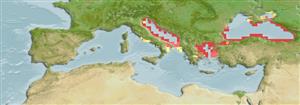Actinoptérygiens (poissons à nageoires rayonnées) >
Perciformes (Perch-likes) >
Gobiidae (Gobies) > Gobiinae
Etymology: Knipowitschia: Because of N.M.Knipowitsch, a zoologist and Russian ichthyologist from the Academy of Sciences. Expeditions in "Pomor" and "Pervosvanniy" ships to Azov and Black sea (1898-1908).
Environnement / Climat / Gamme
Écologie
; marin; eau douce; saumâtre démersal; amphidrome (Ref. 46888); profondeur 0 - 2 m (Ref. 12215). Temperate, preferred ?; 47°N - 38°N, 12°E - 61°E
Eurasia: along the coasts of Black, Azov, Caspian and Aegean seas west to Aliakmon drainage (Greece). Identity of the population along the eastern shore of Adriatic is questionable. Introduced in the Aral Sea and is now extirpated.
Length at first maturity / Taille / Poids / Âge
Maturity: Lm ?, range 2 - 2.3 cm
Max length : 5.0 cm TL mâle / non sexé; (Ref. 4696)
Épines dorsales (Total): 7; Rayons mous dorsaux (Total): 7-8; Épines anales 1; Rayons mous anaux: 7 - 9; Vertèbres: 31 - 32. Anterior oculoscapular, preopercular, and sometimes posterior oculoscapular, canals present; body squamation complete on caudal peduncle and along at least lateral midline to axil. Males with 4-5 major vertical bars.
Inhabit fresh to hyper-saline waters (to 55 ppt) of lakes, estuaries and lagoons, in shallow areas with much weed. Feed on small crustaceans and chironomid larvae (Ref.12215); larvae of the mussel Dreissena polymorpha (Ref. 59043). Lives less than 2 years. Spawns after first winter. Eggs are attached to the roof of a cavity under stones, plant material or shells and are defended by male. Postlarvae are pelagic. (Ref.59043).
Life cycle and mating behavior
Maturité | Reproduction | Frai | Œufs | Fécondité | Larves
Spawns up to 4 portions of eggs (Ref. 59043).
Miller, P.J., 1986. Gobiidae. p. 1019-1085. In P.J.P. Whitehead, M.-L. Bauchot, J.-C. Hureau, J. Nielsen and E. Tortonese (eds.) Fishes of the North-eastern Atlantic and the Mediterranean. Volume 3. UNESCO, Paris. (Ref. 4696)
Statut dans la liste rouge de l'IUCN (Ref. 115185)
CITES (Ref. 94142)
Not Evaluated
Menace pour l'homme
Harmless
Utilisations par l'homme
Outils
Articles particuliers
Télécharger en XML
Sources Internet
